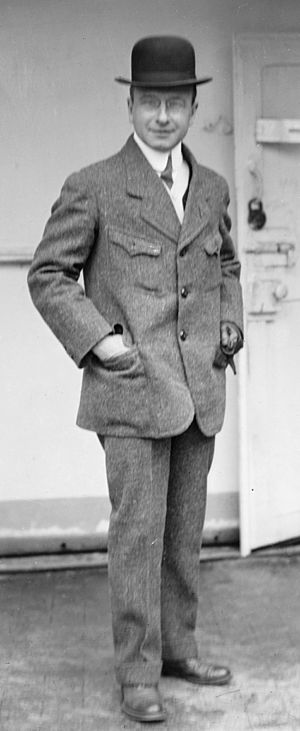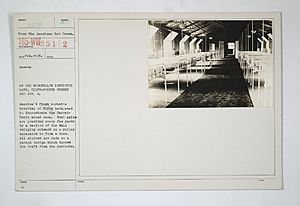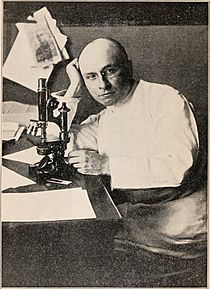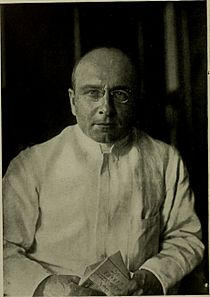Alexis Carrel facts for kids
Quick facts for kids
Alexis Carrel
|
|
|---|---|
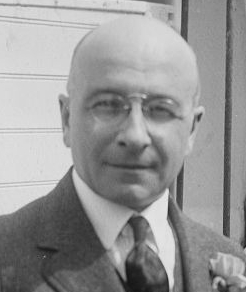 |
|
| Born | 28 June 1873 |
| Died | 5 November 1944 (aged 71) Paris, France
|
| Education | University of Lyon |
| Known for | New techniques in vascular sutures and pioneering work in transplantology and thoracic surgery |
| Medical career | |
| Profession | Surgeon, biologist |
| Institutions | |
| Sub-specialties | transplantology, thoracic surgery |
| Awards | Nobel Prize in Physiology or Medicine (1912) |
| Signature | |
 |
|
Alexis Carrel (born June 28, 1873 – died November 5, 1944) was a French surgeon and biologist. He won the Nobel Prize in Physiology or Medicine in 1912. This award was for his amazing new ways to sew blood vessels together. He also helped invent the first machine to keep organs alive outside the body. This machine was a big step for organ transplants.
Carrel once saw a healing event that he believed was a miracle. This made some of his fellow scientists upset. Because of this, he moved to the United States. He lived there for most of his life. He also played a part in setting up some health policies in Vichy France during World War II.
Contents
Biography
Alexis Carrel was born in Sainte-Foy-lès-Lyon, France. He grew up in a very religious family. He was taught by Jesuits, who are Catholic priests. Later, when he went to university, he became more of a skeptic.
He was a pioneer in transplantology and thoracic surgery. This means he was one of the first to do important work in organ transplants and chest surgery. Carrel was also a member of many important science groups around the world. He received special degrees from several universities, like Princeton University.
In 1902, Carrel said he saw a miraculous healing in Lourdes, France. A woman named Marie Bailly was said to be cured. Carrel was named as a witness. After this event became well-known, Carrel found it hard to get a job in a hospital in France. This was because many people in French universities at the time were against religious beliefs.
So, in 1903, he moved to Montreal, Canada. Soon after, he moved to Chicago, Illinois, in the U.S. There, he worked with an American doctor named Charles Claude Guthrie. They worked on sewing blood vessels and transplanting blood vessels and organs. For this important work, Carrel won the Nobel Prize in 1912.
In 1906, Carrel joined the Rockefeller Institute of Medical Research in New York. He stayed there for the rest of his career. He did important work on growing tissues in a lab with pathologist Montrose Thomas Burrows.
In the 1930s, Carrel became good friends with the famous pilot Charles Lindbergh. They worked together and shared similar ideas. Lindbergh first met Carrel to see if his sister-in-law's heart could be fixed. It was damaged by rheumatic fever. Lindbergh saw that Carrel's equipment was simple. So, he offered to build better machines for Carrel.
Together, they built the first "perfusion pump." This invention was very important for developing organ transplants and open-heart surgery. Lindbergh thought Carrel was his closest friend. He promised to keep Carrel's ideas alive after his death.
Later in his life, Carrel returned to his Catholic faith. In 1939, he met a monk named Alexis Presse. Presse had a big impact on Carrel's life. In 1942, Carrel said he believed in God and the Catholic Church. He asked Presse to be with him when he died in November 1944.
For many years, Carrel and his wife spent summers on an island they owned. After he became friends with Lindbergh, Carrel convinced him to buy a nearby island too. The Lindberghs often stayed there in the late 1930s.
Contributions to Science
Vascular Suture
In 1894, a French president was killed with a knife. He bled to death because a major blood vessel was cut. Doctors at the time couldn't reconnect it. This made a big impression on young Carrel. He decided to find new ways to sew blood vessels.
He developed a technique called "triangulation." This uses three stitches to hold the vessel in place. It helps avoid damaging the vessel wall during surgery. He learned this idea from watching an embroideress sew! This method is still used today. A famous scientist, Julius Comroe, said that Carrel developed almost every technique used in blood vessel surgery today between 1901 and 1910. His success in connecting arteries and veins, and doing surgical grafts, led to his Nobel Prize in 1912.
Wound Antisepsis
During World War I (1914–1918), Carrel worked with a chemist named Henry Drysdale Dakin. They created the Carrel–Dakin method for treating wounds. This method used a special chlorine solution (Dakin's solution). Before antibiotics were invented, this was a huge step forward in caring for serious wounds. For this work, Carrel received a special French award called the Légion d'honneur.
Carrel also pushed for cleaning wounds by cutting away dead tissue. This is called "debridement." He also believed in "irrigation," which means washing wounds with a lot of antiseptic liquid. This helped wash away dirt and germs.
Organ Transplants
Carrel wrote a book with pilot Charles Lindbergh called The Culture of Organs. In the mid-1930s, they worked together to create the "perfusion pump." This machine allowed living organs to stay alive outside the body during surgery. This invention was a key step in developing open-heart surgery and organ transplants. It also set the stage for the artificial heart, which came much later.
Some people said Carrel gave Lindbergh too much credit to get media attention. But others say Lindbergh played a very important role in creating the device. Both Lindbergh and Carrel were featured on the cover of Time magazine in 1938.
Cellular Senescence
Carrel was also interested in aging, or "senescence." He believed that all cells could grow forever. This idea was popular in the early 1900s. In 1912, Carrel started an experiment. He grew tissue from a chicken heart in a special glass flask. He kept this living tissue alive for over 20 years by giving it nutrients. This was much longer than a chicken's normal lifespan. This experiment, done at the Rockefeller Institute, got a lot of attention.
However, no one else could successfully repeat Carrel's experiment. In the 1960s, scientists Leonard Hayflick and Paul Moorhead showed that most cells can only divide a limited number of times before they die. This is called the Hayflick limit. It is now a basic rule in biology.
Scientists are not sure how Carrel got his results. Some think that he might have accidentally added new living cells to his culture each time he fed it.
Honors
In 1972, Sweden honored Carrel with a postage stamp. In 1979, a lunar crater on the Moon was named Carrel after him. This was to celebrate his scientific discoveries.
In 2002, a special award was created in his honor. It is called the Lindbergh-Carrel Prize. It is given to people who make big contributions to keeping organs alive and growing them.
Man, the Unknown (1935)
In 1935, Carrel published a book called Man, the Unknown. It became a very popular book. In it, he tried to explain what was known and unknown about the human body and human life. He wanted to show how discoveries in biology, physics, and medicine could help solve problems in the modern world. He also suggested ways for people to live better lives.
Carrel believed that humanity could improve itself. He thought that society should encourage the development of healthier and more capable individuals. He suggested that people should aim to pass on good qualities to their children. He also thought that society should create conditions where everyone could have a stable life, a home, and a family. He believed that this would help create stronger people and a better society.
French Foundation for the Study of Human Problems
In 1941, during World War II, Carrel helped create the French Foundation for the Study of Human Problems. This foundation was set up by the government in Vichy France. Carrel served as its leader.
The foundation worked on many important topics. These included studying population changes, economics, nutrition, and housing. It also conducted some of the first public opinion surveys in France. The foundation had a large budget and employed about 300 researchers.
The foundation made several positive contributions. It helped create a law in 1942 that required a health certificate before marriage. This was to make sure people were healthy before getting married. It also helped create the livret scolaire. This is an official document that records a student's grades in French schools. It helped track students' academic progress.
After Paris was freed from occupation in 1944, Carrel was suspended from his role. He died in November 1944. However, the foundation itself continued. It later became the Institut national d'études démographiques (INED), which is still active today. Many of Carrel's team members moved to the INED. Others joined the National Hygiene Institute, which later became the INSERM, a major French research institute.
See also
 In Spanish: Alexis Carrel para niños
In Spanish: Alexis Carrel para niños


